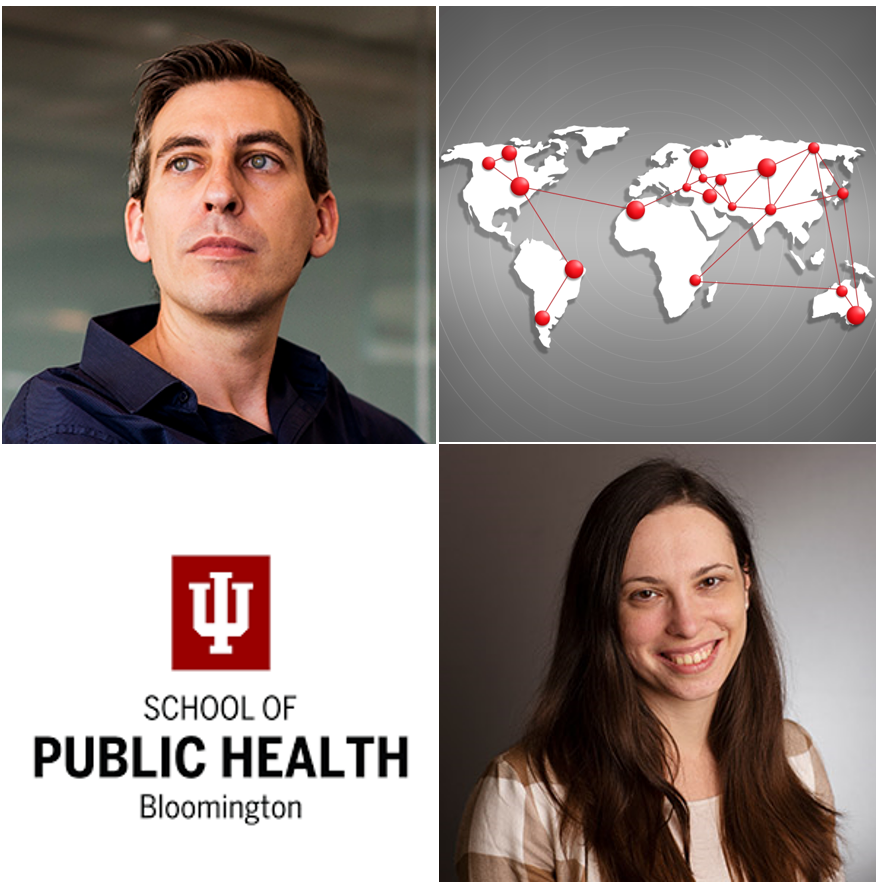It’s not easy to predict when the next viral outbreak will occur, but two faculty members in the Indiana University School of Public Health (SPH-B) Department of Epidemiology and Biostatistics—Associate Professor Marco Ajelli and Assistant Professor Maria Litvinova—are spearheading major innovations on viral forecasting and predictive analytic technology and data communication, thanks to a $2.7 million grant from the Centers for Disease Control and Prevention (CDC). This grant, provided over the course of five years, will fortify the development of an Infectious Disease Forecasting Center at SPH-B. Drs. Ajelli and Litvinova will develop the center (one of only 13 nationwide) in a project entitled “Epistorm: Center for Advanced Epidemic Analytics and Predictive Modeling Technology.”
Dr. Ajelli shared in a recent conversation that other partners in this initiative (University of Florida, Fred Hutchinson Cancer Research Center, and Northeastern University) have been collaborating with SPH-B for more than 12 years on this kind of research, but during the COVID-19 pandemic the CDC saw a real need to start formalizing these efforts and provide much-needed financial support.
“During the pandemic, the CDC understood the importance of having these kinds of collaborations and tools available for decision-making, not just on the federal level but for the state and county as well,” says Dr. Ajelli. “So many more authorities are now looking for what we are providing.”
“In case of an emergency, we need to be able to quickly adapt the technology, implement it, and disseminate information to people who perhaps have never had to work in this area or never seen these kind of tools before,” Dr. Litvinova adds.
Dr. Ajelli says the CDC is asking SPH-B to both optimize the nuances of the technical machinery and best communicate findings to authorities and the public.

“You check a weather forecast and see there is a 25 percent chance of rain. So, you think ‘Well, it might rain but probably not,’” says Dr. Ajelli. “Same when we do an infectious disease forecast—you have a cone of uncertainty—if we expect that on average there may be 50 hospitalizations within the next week, you can get between 25 and 60, and that is our range. Now, the question is, how do we communicate this uncertainty so that decision-makers and the public are better informed? Is it better to communicate the range, the mean, the trend?”
Dr. Litvinova says SPH-B’s biggest contribution will be to fill the information gap about how human behavior within the United States—where people are and how they live—relates to any changes or trends in infectious disease trajectories.

“It is practically a dream come true that we can do this for the U.S., because this information is more or less available in some countries—in some version,” says Dr. Litvinova. “One of the ways we need to improve is to be much more U.S.–specific in terms of the population and experiences of the population that we incorporate into the modeling of infectious diseases.”
Dr. Ajelli explains that there is data on the burden of COVID-19 and influenza among different population groups, but the SPH-B team plans to go deeper by looking at underlying mechanisms that drive the differences in burden. For example, do household interactions and the individual’s job put individuals and their households at higher risk of an infection? If so, how?
“We want to understand why,” says Dr. Ajelli. “We collect the data, analyze the differences and mechanisms, and then we use analytical tools at our disposal to do simulations to check what is the main determinant—or not—of what we are observing at the end. In this way you are not just looking for associations but test the entire chain of events that brought up the result.”
Dr. Litvinova says the benefit of current analytical tools is that the total path of an infection can be simulated, so there are no doubts in terms of the relationship between the cause and the effect.
“We simulate all different options and then analyze which one of them has contributed most to the outcome of higher rates of infection,” she says. “This is the benefit of these analytic tools.”
Learn more about SPH-B faculty’s local and global impact at go.iu.edu/48bx.


